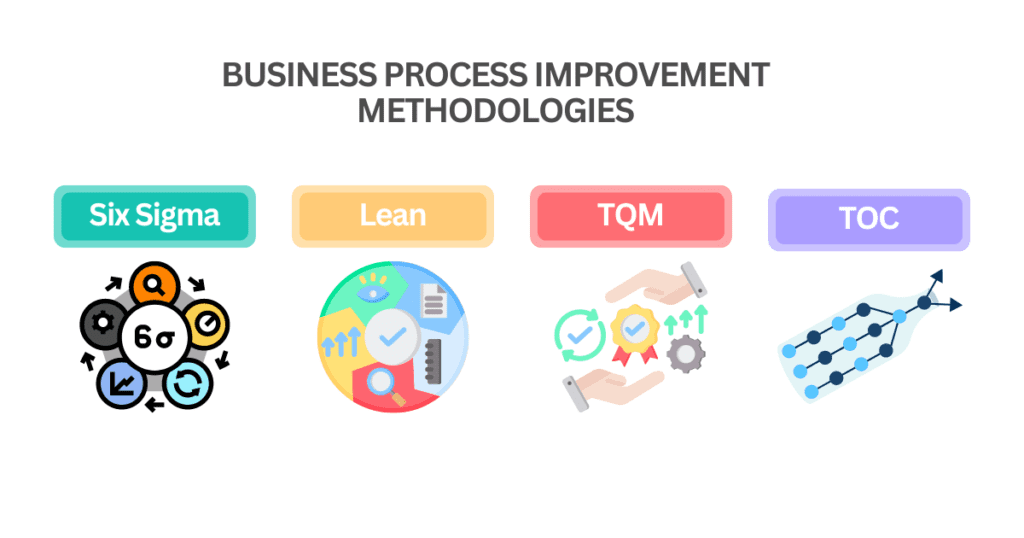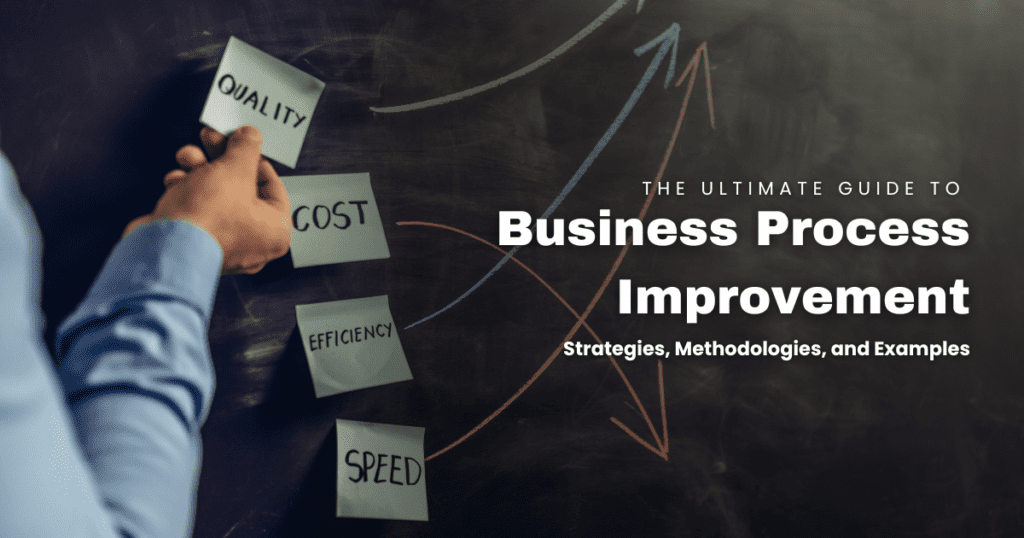Table of Contents
I. Introduction
Business Process Improvement, or BPI, is an organized method employed by companies to enhance the efficiency of their operational procedures. It involves identifying existing processes, analyzing them to pinpoint inefficiencies or bottlenecks, and then redesigning these processes to eliminate these issues. BPI is defined as a management practice used to improve the efficiency and effectiveness of business processes by discovering, mapping, documenting, analyzing, and redesigning processes.
The importance of BPI for organizational efficiency and effectiveness cannot be overstated. BPI targets and eliminates bottlenecks, which are obstacles that hinder the smooth flow of operations, resulting in an overall enhancement of process efficiency. By optimizing resource utilization, BPI maximizes output while minimizing waste, contributing to a more efficient and cost-effective operation. In fact, 57% of companies that implemented process improvement strategies observed improved employee performance. BPI promotes enhanced communication, teamwork, and alignment across departments. By mapping and analyzing processes, organizations can identify areas for improvement in cross-functional workflows, leading to improved teamwork and smoother operations.
The origin of BPI can be traced back to methodologies developed by engineers at companies like Motorola, and it has evolved over time with the introduction of various methodologies such as Lean and Six Sigma. The concept of Agile Management, which derives from managing software development projects, also contributes to the evolution of BPI.
In this article, we will delve deeper into the concept of BPI, its methodologies, and its application in real-world scenarios. We will discuss the cost of inefficient processes, how to identify processes in need of improvement, and various BPI methodologies. We will also provide examples of successful BPI projects and discuss the role of no-code automation software in BPI. Finally, we will provide a glossary of key BPI terms. Let’s embark on this journey to understand and implement Business Process Improvement.
II. Understanding Business Process Improvement
Business Process Improvement (BPI) is a systematic approach that organizations use to identify, analyze, and improve their operational processes. It involves pinpointing existing processes, analyzing them to identify inefficiencies or bottlenecks, and then redesigning these processes to eliminate these issues. The ultimate goal of BPI is to ensure a highly perceived value delivery to the end customer.
The objectives and goals of BPI are to define goals, workflow, control, and integration with other processes. BPI is focused on enhancing its digital capabilities to deliver a secure, user-friendly digital experience across platforms, adhering to banking standards, policies, and global best practices.
Implementing BPI in organizations brings numerous benefits. It encourages smoother operations, more efficient workflows, happier teams, customers, and partners, as well as overall business growth. BPI is a continuous exercise that helps supercharge business operations. The incremental improvement of business processes has positive business and personal outcomes, all leading to better operations and better living. Some of the key benefits of implementing BPI include cost reduction, increased quality, enhanced customer satisfaction, and improved employee satisfaction. By embracing BPI, organizations can benefit from enhanced operational efficiency, cost reduction, and increased agility and resilience. These advantages enable organizations to seize opportunities for growth and remain competitive in the market.
III. The Cost of Inefficient Processes

Inefficient processes can have a significant impact on businesses. They can complicate processes, hamper operations, and ultimately lead to a loss in revenue. Market research conducted by IDC suggests that companies experience a loss of 20% to 30% in revenue annually due to inefficiencies. Inefficient processes can slow down production, decrease morale, lower profits, and decrease client satisfaction. They can also lead to a waste of money that isn’t returning benefits.
Quantifying the cost of inefficiency is a complex task as it involves considering both direct and indirect costs. Direct costs refer to the monetary losses incurred due to inefficient processes, while indirect costs refer to the opportunity costs associated with wasted time and resources. One common method of quantifying inefficiency is by calculating the time wasted per employee and multiplying that by the employee’s hourly earnings. Another method is the measured mile analysis, which compares the productivity of work during periods of disruption with the productivity during periods of normal operations.
The importance of addressing process inefficiencies cannot be overstated. By tackling inefficiencies, organizations can reduce the occurrence of conflicts and foster internal alignment, better equipping them to adapt to change. It opens the doors of opportunities for growth and improvement and promotes change management within the organization. By identifying and addressing inefficiencies, organizations can optimize their operations, increase profitability, and enhance competitiveness. Therefore, it’s crucial for businesses to continuously evaluate and streamline their processes to eliminate any roadblocks that may hinder growth and success.
IV. Identifying Processes in Need of Improvement
Identifying processes in need of improvement is a crucial step in the journey towards business process improvement. It involves a systematic approach, assessment of current workflows and performance metrics, and the use of specific tools and methodologies.
A systematic approach to identifying processes for improvement involves a continuous cycle of evaluation and improvement geared towards achieving the best possible outcomes. This strategy prioritizes enhancing effectiveness, efficiency, and customer satisfaction. It involves studying, understanding, and evaluating the sequence of tasks, activities, and interactions that make up a specific business process or operation within an organization.
The steps to assess current workflows, performance metrics, and stakeholder feedback involve first defining the scope and objectives of the analysis, followed by gathering relevant data and information about the current workflows in the organization. Performance metrics are then analyzed to measure the effectiveness of performance management strategies. Stakeholder feedback is collected to ensure that the project, organization, or processes are aligned with the needs or expectations of your stakeholders.
There are several tools and methodologies for identifying process improvement opportunities. These include Six Sigma, a process improvement methodology that aims to minimize the amount of variations within the end product. Other methodologies include Lean manufacturing, Total Quality Management (TQM), Just-in-time, Theory of Constraints, Kaizen, PDCA model, Process mapping, Kanban, People, process, technology framework, 5S method, SIPOC analysis, and Value stream mapping (VSM). These methodologies offer various ways to analyze, visualize, and assess workflows, pinpointing inefficiencies and areas for enhancement.
By identifying processes in need of improvement, organizations can optimize their operations, increase profitability, and enhance competitiveness. Therefore, it’s essential for businesses to consistently assess and streamline their processes, removing any obstacles that could impede growth and success.
Related: A Comprehensive Guide to Process Improvement Methodologies
V. Business Process Improvement Methodologies

Six Sigma
Overview of Six Sigma methodology
Six Sigma is a collection of methods and tools used for business process improvement and quality management. It was introduced by engineer Bill Smith at Motorola in 1986. The primary objective of Six Sigma is to improve the efficiency of business processes by discovering, mapping, documenting, analyzing, and redesigning processes. The term “Six Sigma” is derived from the bell curve used in statistics, where sigma represents the standard deviation from the mean. A process operating at Six Sigma will achieve an exceptionally low defect rate.
DMAIC framework and its application in process improvement
The DMAIC (Define, Measure, Analyze, Improve, Control) framework is a key component of the Six Sigma methodology. DMAIC is a data-focused quality management system used to improve processes. The five phases of the DMAIC process are:
- Define: Define the problem, improvement activity, opportunity for improvement, the project goals, and customer (internal and external) requirements.
- Measure: Measure the initial performance of the process, creating a benchmark.
- Analyze: Analyze the process to determine root causes of variation, poor performance (defects).
- Improve: Improve process performance by identifying and eliminating root causes.
- Control: Maintain control over the improved process and future performance.
Use cases and strengths of Six Sigma
Six Sigma has been successfully applied across a wide range of industries and sectors to improve operational efficiency and quality. Some of the key strengths of Six Sigma include:
- Enhanced Quality: Six Sigma focuses on quality improvement by systematically identifying and addressing defects, errors, and process variations.
- Process Optimization: Six Sigma emphasizes process optimization by identifying and eliminating waste and inefficiencies.
- Data-Driven Decision Making: Six Sigma relies heavily on data analysis to drive decision-making, ensuring that decisions are based on proper facts and data rather than opinions or gut feelings.
- Increased Customer Satisfaction: Six Sigma plays a crucial role in enhancing customer satisfaction by improving the quality of products and services.
Related: 10 Six Sigma Tools: A comprehensive overview of their application in Root Cause Analysis
Lean
Introduction to Lean methodology
Lean methodology is a set of business principles that prioritize continuous improvement, eliminating waste, and respect for people. It was developed by Toyota Founder Kiichiro Toyoda after World War II to conserve resources and eliminate waste. The core idea of Lean is quite simple: relentlessly work on eliminating waste from the manufacturing process. What is waste?
It may manifest in various ways, but the core concept is to remove anything that doesn’t contribute value from your customer’s viewpoint.
Principles of Lean and its focus on waste reduction
The principles of Lean methodology are based on two pillars: Continuous improvement and respect for people. Continuous improvement involves an ongoing feedback loop that helps teams make progressive changes to processes, products, and personnel to improve systems continuously. Respect involves recognizing the value of team contributions and customer feedback, and taking those insights and ideas seriously.
Lean prioritizes eliminating waste to deliver maximum value to customers while optimizing resource usage. It identifies eight types of waste, including overproduction, waiting time, and unnecessary transportation, among others. By tackling these inefficiencies, Lean aims to streamline processes and foster a more adaptable and agile organization.
Application of Lean in Optimizing Processes
Applying Lean principles to improve processes involves a systematic approach. Here are four steps to integrate it within a company:
- Identify potential areas for improvement: Assemble your team and conduct a thorough evaluation of your existing processes.
- Identify potential solutions: Once you pinpoint improvement areas, involve the team in finding potential solutions.
- Implement improvements: Implementing change can be challenging. Ensure you have a plan in place to manage the transition smoothly.
- Monitor outcomes: Implementing solutions is not the end of the process. Continually monitor the outcomes and adjust as necessary.
By applying Lean methodology, businesses can eliminate waste, improve processes, and boost innovation, leading to a more productive, healthier, and more innovative future.
Total Quality Management (TQM)
Understanding TQM and its principles
Total Quality Management (TQM) is a management approach to long-term success through customer satisfaction. It involves all members of an organization participating in improving processes, products, services, and the culture in which they work. In summary, TQM is a management system that prioritizes customers and engages all employees in ongoing improvement, integrating quality practices into the organization’s culture and activities through strategy, data, and communication.
The eight principles of TQM are:
- Customer Focus: The customer ultimately determines the level of quality. Regardless of the actions an organization takes to improve quality—such as training employees, integrating quality into design, or upgrading technology—the customer ultimately decides if the efforts are worthwhile.
- Total Employee Involvement: All employees participate in working toward common goals. Total employee commitment can only be obtained after fear has been driven from the workplace, when empowerment has occurred, and when management has provided the proper environment.
- Process-Centered: TQM emphasizes thinking in terms of processes. A process involves steps that take inputs from suppliers (external or internal) and turn them into outputs for customers (external or internal).
- Integrated System: TQM focuses on the horizontal processes, connecting different functional areas within an organization, rather than individual departments.
- Strategic and Systematic Approach: TQM involves a strategic and systematic approach to realizing an organization’s vision, mission, and goals.
- Continual Improvement: TQM is not a one-time process, but a continuous one. It involves a commitment to continuously improve the quality of products and processes.
- Fact-Based Decision Making: In order to know how well an organization is performing, data on performance measures are necessary. TQM needs organizations to always gather and study data for better decisions, agreement, and predicting trends based on past experiences.
- Communications: Effective communication is crucial for keeping morale high and motivating employees at all levels, both during organizational changes and in everyday operations.
Company-wide approach to quality improvement
TQM emphasizes a whole-company approach across functions and departments. Senior leadership leads TQM through goal setting, training, and effective communication. A fundamental part of TQM is assessing and redefining processes, monitoring performance, and using the results to drive further improvements. Improvement ideas should consider the entire process, not just individual tasks. Each area should take responsibility for the overall quality of the final product or service.
Use cases and benefits of TQM in process enhancement
TQM boosts profits by improving quality and tackling related challenges in an organization. TQM can be used to increase productivity, lower scrap and rework costs, improve product reliability, decrease time-to-market cycles, decrease customer service problems, and increase competitive advantage. By consistently discovering insights on process gaps and challenges, TQM helps create new value and innovation, enabling companies to maintain high standards of quality, productivity, and safety at reasonable costs.
Theory of Constraints (TOC)
Overview of TOC methodology
The Theory of Constraints (TOC) is a management concept that suggests complex systems, like production or business operations, are held back from reaching their goals by a few key constraints. Introduced by Dr. Eliyaho M. Goldratt in 1984 in his book “The Goal,” TOC has become a fundamental tool in operations management and strategic planning.
Its core idea is identifying constraints or bottlenecks in a process that hinder overall performance, which could be anything preventing the process from achieving its goal. The goal in terms of business is usually to make a profit but this could vary depending on the organization and its overall objectives. The goal of TOC is to systematically manage these constraints and improve process performance.
Five Focusing Steps and their application in process optimization
The theory of constraints is applied using a series of steps that are known as the five focusing steps. These steps are designed to find and manage bottlenecks or constraints efficiently:
- Identify the Constraint: The first step involves identifying the most significant limiting factor (the bottleneck) in the system.
- Exploit the Constraint: Once the constraint is identified, the next step is to exploit it. This involves finding ways to maximize the use of limited resources without needing a lot of extra spending.
- Subordinate Everything Else: This step involves aligning the entire system to support the exploited constraint.
- Elevate the Constraint: If the constraint cannot be broken, decisions must be made to elevate the performance of the constraint.
- Repeat the Process: If in the previous steps a constraint has been broken, go back to step 1. Don’t let things stay the same and create a new problem.
Use cases and strengths of TOC in identifying and eliminating bottlenecks
TOC has been used in a wide range of industries and domains from manufacturing to software development to project management to healthcare. TOC’s Five Focusing Steps offer a clear way to find and handle bottlenecks, whether they’re inside or outside the organization. Implementing TOC entails a continuous cycle of identifying constraints, exploiting them to their fullest, aligning the entire system to support these constraints, and, if necessary, elevating their performance. This approach leads to substantial gains in efficiency and profitability, applicable across diverse organizational structures and industries.
VI. How to Improve a Process

Improving a process involves a systematic approach that includes initiating and implementing process improvements, setting clear objectives and goals, analyzing, prioritizing, and planning process improvements, and the continuous refinement of process improvements.
Steps for initiating and implementing process improvements
Initiating and implementing process improvements involve a series of steps:
- Identify the Improvement Opportunity: The first step is to identify the specific process or workflow to be improved.
- Obtain Stakeholder Buy-In: It’s crucial to get the support of all stakeholders involved in the process.
- Design the Process Improvement Plan: This involves creating a detailed plan outlining the changes to be made.
- Test the Changes: Implement the changes on a small scale to test their effectiveness.
- Monitor and Optimize: Regularly monitor and track process performance, gather feedback, and sustain improvements.
Related: What are the 5 key elements of process improvement?
Importance of setting clear objectives and goals
Setting clear objectives and goals is critical to the success of any process improvement initiative. Clear, realistic, and achievable goals enable employees to perform better and accurately evaluate results. Goals also help align your focus and promote a sense of self-mastery. Simply put, if you don’t measure something, you can’t manage it, and if you don’t manage it, you can’t improve it.
Strategies for analyzing, prioritizing, and planning process improvements
Analyzing, prioritizing, and planning process improvements involve several strategies:
- Analyze Current Processes: This involves examining the current processes and workflows to identify areas of improvement.
- Prioritize Improvements: Not all improvements can be implemented at once. Prioritizing helps determine which improvements will have the most significant impact.
- Plan for Implementation: This involves creating a detailed plan for implementing the improvements.
Related: 10 Pioneering Process improvement tools to optimize business performance
Implementation, monitoring, and continuous refinement of process improvements
The implementation of process improvements is just the beginning. It’s crucial to monitor the impact of these improvements on performance metrics. Regular assessments, feedback from stakeholders, and adjustments to the plan are necessary to ensure sustained success in optimizing processes and capitalizing on identified opportunities for enhancement. This is the essence of continuous improvement – it’s an ongoing cycle of planning, implementing changes, evaluating results, and adjusting the approach based on feedback.
Related: 11 ideas for process improvement: Examples & tips
VII. Examples of Business Process Improvement Projects
Streamlining Inventory Management: Inventory management is a crucial aspect of any business, especially in the manufacturing and retail sectors. Streamlining inventory management means improving how a company orders, stores, and uses its inventory, which includes raw materials, parts, and finished products. This can be achieved by implementing automated systems for tracking inventory levels, sales data, and procurement information. Effective inventory management can lead to reduced holding costs, improved cash flow, and increased profitability.
A company implemented a BPI project to streamline its inventory management process. The project involved optimizing the process of ordering, storing, and using the company’s inventory. As a result, the company reduced its shipment process time by 35%, increased shipment accuracy by 25%, and reduced finished goods inventory on hand by 10%.
Readers Note: Sharing specific company names and details may require permissions or could potentially infringe on privacy or confidentiality agreements. Therefore, it’s common practice to share examples in a way that illustrates the concept without disclosing specific company details.
- Automating Invoice Processing: Automating invoice processing can significantly improve efficiency and accuracy in the finance department. It involves using software to capture, extract, and validate key data from invoices, and then delivering the data to the company’s information systems for straight-through processing of invoices. This not only reduces manual effort but also minimizes errors and accelerates the invoice processing workflow.
A company automated its invoice processing to improve efficiency and accuracy. The company used software to capture, extract, and validate key data from invoices, then delivered the data to the company’s information systems for straight-through processing. This not only reduced manual effort but also minimized errors and accelerated the invoice processing workflow.
- Enhancing Customer Service with Chatbots: AI-powered chatbots are transforming customer service by providing instant, personalized responses to customer queries. They can handle a wide range of tasks, from answering frequently asked questions to guiding users through complex processes. This not only makes customers more satisfied but also lets customer service workers focus on more difficult issues.
A company enhanced its customer service by implementing AI-powered chatbots. The chatbots provided instant, personalized responses to customer queries, handling a wide range of tasks from answering frequently asked questions to guiding users through complex processes. This improved customer satisfaction and freed up human customer service representatives to handle more complex issues.
- Optimizing Employee Onboarding: A well-structured onboarding process can significantly improve new employee productivity and retention. This involves providing new hires with all the necessary information, tools, and training they need to become productive members of the team. It can also include mentorship programs and continuous feedback mechanisms to ensure new employees are well-supported throughout their initial period in the company.
A company optimized its employee onboarding process to improve new employee productivity and retention. The company provided new hires with all the necessary information, tools, and training they needed to become productive members of the team. It also included mentorship programs and continuous feedback mechanisms to ensure new employees were well-supported throughout their initial period in the company.
- Implementing Remote Work Policies: With the rise of remote work, implementing effective remote work policies has become crucial for businesses. This involves setting clear expectations, providing the necessary tools and support for remote work, and establishing communication and accountability mechanisms. A well-implemented remote work policy can lead to increased productivity, improved work-life balance, and reduced overhead costs.
With the rise of remote work, a company implemented effective remote work policies. The company set clear expectations, provided the necessary tools and support for remote work, and established communication and accountability mechanisms. As a result, the company saw increased productivity, improved work-life balance, and reduced overhead costs.
- Streamlining Project Management: Streamlining project management involves optimizing the processes involved in planning, executing, and controlling projects. This can be achieved through the use of project management software, implementation of standardized project management methodologies, and continuous improvement initiatives.
A company streamlined its project management process. The company implemented standardized project management methodologies and continuous improvement initiatives. This led to improved project outcomes and increased efficiency.
- Improving Supplier Relationship Management: Effective supplier relationship management involves building strong, mutually beneficial relationships with suppliers. This can be achieved through regular communication, collaborative problem-solving, and strategic alignment. Improved supplier relationships can lead to better pricing, improved product quality, and more reliable delivery schedules.
A company improved its supplier relationship management process. The company built strong, mutually beneficial relationships with suppliers through regular communication, collaborative problem-solving, and strategic alignment. This led to better pricing, improved product quality, and more reliable delivery schedules.
- Enhancing Data Security: Data security involves protecting digital information from unauthorized access, corruption, or theft. This can be achieved through a combination of technical measures (such as encryption and access controls), administrative policies, and employee training. Enhancing data security can protect a company from financial loss, reputational damage, and legal penalties.
A company enhanced its data security process. The company implemented technical measures such as encryption and access controls, administrative policies, and employee training. This protected the company from financial loss, reputational damage, and legal penalties.
- Reducing Production Waste: Reducing production waste involves optimizing manufacturing processes to minimize the amount of waste produced. This can be achieved through the implementation of lean manufacturing techniques, efficient resource management, and continuous improvement initiatives. Reducing waste can lead to cost savings, improved efficiency, and reduced environmental impact.
A company reduced its production waste. The company optimized its manufacturing processes to minimize the amount of waste produced. This led to cost savings, improved efficiency, and reduced environmental impact.
- Enhancing Employee Training and Development: Employee training and development programs are essential for improving the skills and knowledge of the workforce. This can be achieved through a combination of on-the-job training, seminars, mentorship programs, and e-learning. Enhancing employee training and development can lead to improved performance, increased job satisfaction, and higher retention rates.
A company enhanced its employee training and development programs. The company implemented a combination of on-the-job training, seminars, mentorship programs, and e-learning. This led to improved performance, increased job satisfaction, and higher retention rates.
Each of these examples illustrates the successful implementation of business process improvement projects. The key takeaways from these examples include the importance of clear communication, strategic planning, continuous improvement, and the effective use of technology. By learning from these examples, businesses can identify opportunities for improvement in their own processes and implement effective solutions to enhance efficiency, reduce costs, and improve overall performance.
VIII. Process Improvement with No-Code Automation Software

Overview of no-code automation software and its role in BPI
No-code automation software refers to the platforms that allow businesses to automate tasks that are manual or repetitive, leading to efficiency and cost savings. It optimizes workflows with intuitive, user-friendly interfaces for those with no previous coding knowledge or experience. No-code automation tools are important for managing business processes and workflows. Many businesses use these tools to solve problems caused by redoing tasks, mistakes, and slow manual workflows.
Advantages of using no-code platforms for process improvement
No-code platforms offer numerous benefits that are hard for businesses to overlook. Some of the key advantages include:
- Speed of Deployment: One of the biggest advantages is the ability to quickly build and deploy applications. This significantly reduces the time-to-market for new applications.
- Cost Savings: No-code platforms can help businesses cut down or even avoid the expenses of hiring or outsourcing software development.
- Democratization of Application Development: Employees without technical backgrounds can create applications, fostering a culture of innovation.
- Flexibility and Scalability: As business requirements change, applications built on no-code platforms can be easily adapted without starting from scratch.
- Reduced IT Backlog: IT departments often have long backlogs of projects. No-code platforms let business teams make their own solutions, reducing dependence on IT and cutting down the backlog.
- Prototyping and MVPs: Before investing in full-fledged development, businesses can use no-code tools to create prototypes or minimum-viable products for testing and validation.
- Empowerment of Citizen Developers: By enabling non-technical staff to develop solutions, businesses can tap into a broader pool of talent and ideas.
- Standardized and Secure Environment: Many no-code platforms come with security features to make sure applications meet safety standards.
- Integrations: Modern no-code platforms often come with a wide range of pre-built integrations, allowing businesses to seamlessly connect different software solutions.
- Easy Maintenance: Traditional software might require updates and patches, often necessitating developer involvement. No-code solutions typically come with easier maintenance paths.
- Cost Predictability: In traditional development, unforeseen problems can make costs go up. No-code platforms generally offer more predictable pricing.
- Collaboration: No-code platforms encourage teamwork across departments, allowing both tech-savvy and non-tech teams to participate in development.
- Custom Solutions: While off-the-shelf software might not cater to the unique needs of every business, no-code platforms can be tailored to fit specific business requirements.
Case studies or examples of organizations leveraging no-code automation for BPI
Here are some examples of organizations leveraging no-code automation for BPI:
- Aon Italy: Aon Italy used IBM’s no-code platform to ease the workloads of the company’s 1,600 employees.
- Cobmax Sales Center: Cobmax Sales Center in Brazil used IBM’s no-code platform to reduce client reports completion time from 2-3 days to 1 day.
- Credigy Solutions Inc.: Credigy Solutions Inc. in the United States used IBM’s no-code platform to automate due diligence reviews of loan-related documents.
- Deloitte: Deloitte used IBM’s no-code platform to reduce management report preparation time from 5-8 days to 1 hour and travel expense report preparation time from 3 hours a day to 10 minutes.
- GAM Distributors of Medicines and Perfumery: GAM Distributors of Medicines and Perfumery in Brazil used IBM’s no-code platform to automate 22 processes within a year, saving around BRL 120,000 per year.
- Inter Aduaneira: Inter Aduaneira in Brazil used IBM’s no-code platform to save 800 hours per analyst and improve response times by 80% in some sectors of the company.
- Lojacorr Network: Lojacorr Network in Brazil used IBM’s no-code platform to increase process execution efficiency by 80%.
- System of Credit Unions of Brazil: System of Credit Unions of Brazil used IBM’s no-code platform to save up to 80% time and achieve 10%-20% cost savings.
These examples illustrate how no-code automation can be leveraged to improve business processes, enhance efficiency, and drive innovation.
Related: 10 Best No-Code Platforms for Process Automation
IX. Conclusion
In this article, we’ve explored the concept of Business Process Improvement (BPI) and its importance in enhancing organizational efficiency and effectiveness. We’ve delved into the cost of inefficient processes and the significance of identifying processes in need of improvement. We’ve also examined various BPI methodologies, including Six Sigma, Lean, Total Quality Management (TQM), and the Theory of Constraints (TOC).
We’ve discussed the steps for initiating and implementing process improvements, the importance of setting clear objectives and goals, and strategies for analyzing, prioritizing, and planning process improvements. We’ve also looked at the implementation, monitoring, and continuous refinement of process improvements.
We’ve provided examples of BPI projects and discussed the role of no-code automation software in BPI. Each of these sections has offered insights into the different aspects of BPI, providing a comprehensive guide for anyone interested in this field.
The importance of continuous improvement and adaptability in BPI cannot be overstated. In an ever-changing business environment, the ability to adapt and improve is crucial for long-term success. BPI provides the tools and methodologies to make this possible, enabling organizations to optimize their processes, reduce costs, and enhance overall performance.
Finally, we encourage businesses to embrace BPI initiatives for long-term success. Whether you’re looking to streamline your inventory management, automate invoice processing, enhance customer service, or any other process, BPI offers a systematic and effective approach to achieving these goals.
Remember, the journey of improvement is ongoing and requires a commitment to learning and adapting. But with the right mindset and tools, businesses can transform their processes, improve efficiency, and achieve greater success. So, why wait? Start your BPI journey today!
XI. Glossary
Here are some definitions of key terms and concepts related to Business Process Improvement (BPI):
- Business Process Improvement (BPI): A systematic approach that organizations use to identify, analyze, and improve their operational processes.
- Six Sigma: A collection of methods and tools used for business process improvement and quality management.
- Lean: A set of business principles that prioritize continuous improvement, eliminating waste, and respect for people.
- Total Quality Management (TQM): A management approach to long-term success through customer satisfaction.
- Theory of Constraints (TOC): A management philosophy that suggests that a complex system, such as production processes or business operations, is limited in achieving its goals by a small number of constraints.
- DMAIC: A data-focused quality management system used to improve processes. The five phases of the DMAIC process are: Define, Measure, Analyze, Improve, and Control.
- No-Code Automation Software: Software platforms that empower businesses to automate manual or repetitive work for efficiency and cost savings.
- Inventory Management: The process of ordering, storing, and using a company’s inventory: raw materials, components, and finished products.
- Invoice Processing: The process that a company uses to pay its bills from receipt of an invoice to payment.
- Customer Service: The support a company gives to its customers who use or purchase its products or services.
- Employee Onboarding: The process of integrating a new employee into a company and its culture, as well as getting them up to speed on their new job.
- Remote Work Policies: Guidelines that companies follow to ensure that its employees who work from home are productive and can communicate effectively.
- Project Management: The process of starting, organizing, implementing, monitoring, and completing a team’s work to reach certain objectives and fulfil specific success standards within a set timeframe.
- Supplier Relationship Management: The strategic approach to planning and managing all dealings with third-party entities that provide goods or services to a company, with the aim of getting the most value from these interactions.
- Data Security: The process of protecting digital information from unauthorized access, corruption, or theft.
- Production Waste: Any materials or substances that are not useful or wanted and that have been thrown away.
- Employee Training and Development: The ongoing process of providing staff with the knowledge and skills they need to do their jobs effectively.






